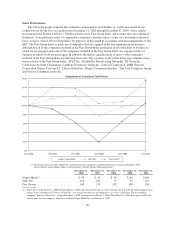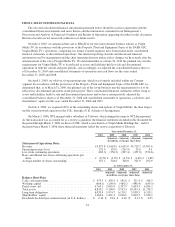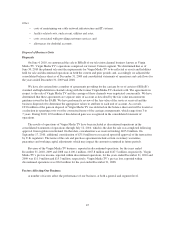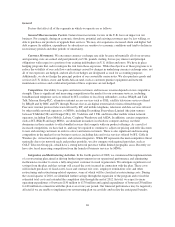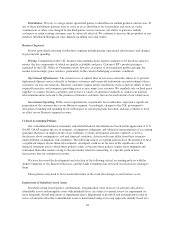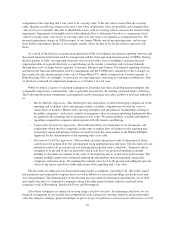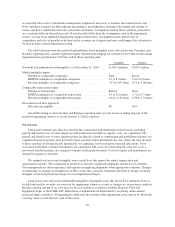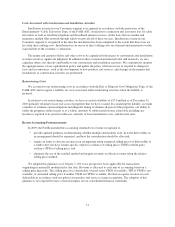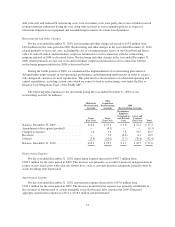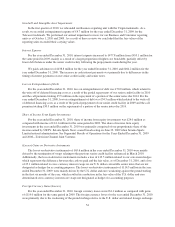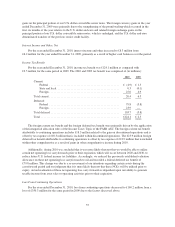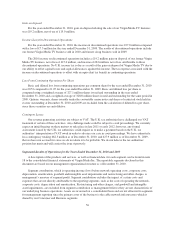Virgin Media 2010 Annual Report Download - page 52
Download and view the complete annual report
Please find page 52 of the 2010 Virgin Media annual report below. You can navigate through the pages in the report by either clicking on the pages listed below, or by using the keyword search tool below to find specific information within the annual report.comparison of the reporting unit’s fair value to its carrying value; if the fair value is lower than the carrying
value, then the second step compares the asset’s fair value (implied fair value for goodwill and reorganization
value in excess of amounts allocable to identifiable assets) with its carrying value to measure the amount of the
impairment. Impairment of intangible assets with indefinite lives is determined based on a comparison of fair
value to carrying value. Any excess of carrying value over fair value is recognized as an impairment loss. We
incurred impairment charges in 2008 in respect of our former Mobile and sit-up reporting units, and we may
incur further impairment charges if, for example, market values decline or we do not achieve expected cash
flows.
As a result of the business reorganization initiated in 2008, we realigned our internal reporting structure and
the related financial information used by management and the chief operating decision maker (CODM). During
the first quarter of 2009, our operating structures were revised with a view to building a customer-focused
organization able to respond effectively to rapid changes in the market, technology and customer demands
through three new customer-based segments: Consumer, Business and Content. Our internal reporting structure
and the related financial information used by management and the CODM were amended to reflect changes we
have made after the announcement of the sale of Virgin Media TV, which comprised our Content segment, to
BSkyB in June 2010. Accordingly, we now have two reporting units consisting of Consumer and Business, both
of which are evaluated for impairment purposes as at October 1 of each year.
While we utilize a variety of valuation techniques to determine fair value, including market multiples and
comparable transactions, estimated fair value is generally measured by discounting estimated future cash flows.
The following discussion summarizes each approach used to determine fair value and how it has been utilized by
us:
•Market Multiple Approach—This method provides indications of value based upon comparisons of the
reporting unit to market values and pricing evidence of public companies involved in the same or
similar lines of business. Market ratios (pricing multiples) and performance fundamentals relating to
the public companies’ stock prices (equity) or enterprise values to certain underlying fundamental data
are applied to the reporting unit to determine its fair value. We utilize publicly available information
regarding comparable companies which operate in North America and Europe.
•Comparable Transaction Approach—This method includes an examination of recent mergers and
acquisitions which involves companies in the same or similar lines of business to the reporting unit.
Acquisition values and pricing evidence are used in much the same manner as the Market Multiple
Approach for the determination of the reporting unit’s fair value.
•Discounted Cash Flow Approach—This method calculates the present value of the projected future
cash flows to be generated by the reporting unit using appropriate discount rates. The discount rates are
intended to reflect all associated risks of realizing the projected future cash flows. Terminal value is
computed as of the end of the last period for which cash flows are projected utilizing a terminal
multiple to determine an estimate of the value of the reporting unit as of that future point in time. The
terminal multiple employed is estimated utilizing the information attained regarding comparable
companies and transactions. Discounting the terminal value back to the present and adding the present
values of the future cash flows yields indications of the reporting unit’s fair value.
The discount rate employed was determined using market assumptions (including U.K. Gilt yields, equity
risk premiums and comparable company betas) as well as Ibbotson’s research (including size decile betas and
size risk premiums). The determination of the discount rate also utilized information regarding the cost of debt
and capital structures of comparable companies along with other general market reference materials from
companies such as Bloomberg, Standard & Poors and Morningstar.
All of these techniques are reliant on our long range cash flow forecasts. In estimating cash flows, we use
financial assumptions in our internal forecasting model such as projected customer numbers, projected product
sales mix and price changes, projected changes in prices we pay for purchases of fixed assets and services as well
49



